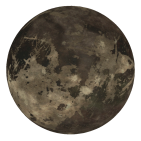Celestial bodies
Currently, KSP2 has one star system, the Kerbolar System. At least three other star systems are planned to be added to the game in the interstellar update.
Kerbolar System
The Kerbolar System is currently the only star system available in KSP2. It is the analog of the real life Solar System in KSP2. The central star, Kerbol, is orbited by seven planets, including two dwarf planets, and nine moons. Kerbol itself is a G-type star, much like the real-world Sun, and it hosts two worlds with oceans and oxygenated atmospheres: Kerbin and Laythe. Kerbol appears to produce orange/yellow light, unlike the actual Sun, which produces white light.
| Celestial Body | Name | Parent Body | Body Type | Gravity (g) | Atmosphere height (m) | Atmosphere
density (atm) |
|---|---|---|---|---|---|---|
 |
Kerbol | N/A | Star | 1.747 | 600,000 | 0.16 |
 |
Moho | Kerbol | Planet | 0.275 | N/A | N/A |
 |
Eve | Kerbol | Planert | 1.701 | N/A | 6.24 |
 |
Gilly | Eve | Moon | 0.005 | N/A | N/A |
 |
Kerbin | Kerbol | Planet | 1.000 | 70,000 | 1.22 |
 |
Mun | Kerbin | Moon | 0.166 | N/A | N/A |
 |
Minmus | Kerbin | Moon | 0.050 | N/A | N/A |
 |
Duna | Kerbol | Planet | 0.300 | 50,000 | 0.15 |
 |
Ike | Duna | Moon | 0.112 | N/A | N/A |
 |
Dres | Kerbol | Dwarf | 0.115 | N/A | N/A |
 |
Jool | Kerbol | Planet | 0.800 | 200,000 | 6.70 |
 |
Laythe | Jool | Moon | 0.800 | 50,000 | 0.76 |
 |
Vall | Jool | Moon | 0.235 | N/A | N/A |
 |
Tylo | Jool | Moon | 0.800 | N/A | N/A |
 |
Bop | Jool | Moon | 0.060 | N/A | N/A |
 |
Pol | Jool | Moon | 0.038 | N/A | N/A |
 |
Eeloo | Kerbol | Dwarf | .172 | N/A | N/A |